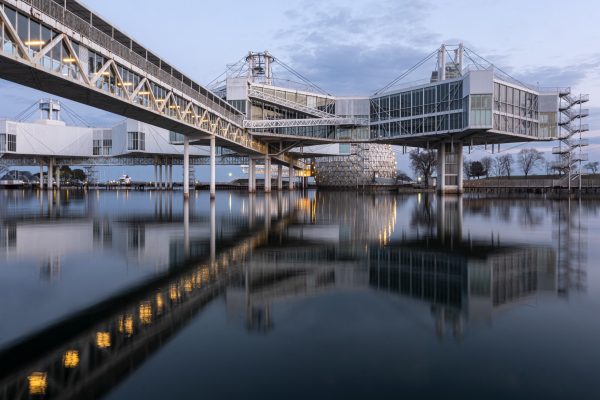
In back-to-back water’s edge press conferences last week, Ana Bailao and Josh Matlow planted their respective flags on the West Island at Ontario Place, each arguing that the Ford government’s plan to build a $350 million spa there is inconsistent with the the city’s waterfront goals.
Bailao’s pitch is that the province should move the Ontario Science Centre down to Ontario Place and build 5,000 units of housing, including 1,500 affordable ones, on the OSC’s city-owned parking lot. “We can responsibly develop Ontario Place while addressing the housing crisis,” she said. “Instead of spending $500 million of taxpayer money to subsidize a private spa that the majority of ton of Torontonians cannot afford this proposal, builds housing and keeps Ontario Place open for Torontonians.”
Matlow, in turn, said that if he was elected mayor, he’d block the planned sale of 16 acres of City-owned land and water lots that abut Ontario Place as a means of preventing the redevelopment proposal from going ahead. “The city does have a choice as to whether or not it will consent to the sale of the city property given that it does legally belong to us,” he said. “My position is that our waterfront isn’t for sale, and it’s certainly not for sale to privatize our waterfront to allow for a big private spa.”
While they agree that a 700,000 sq-ft private human aquarium doesn’t belong on one of the most iconic spots on the city’s lakefront, Bailao and Matlow’s respective stances offer voters some clues about how they would manage the always fraught relationship between City Hall and Queen’s Park, both on this specific issue and perhaps more generally.
A couple of important points about the city’s positionality. The Ontario Place project involves a development application to the city that requires an official plan amendment, public consultation and, possibly, federal approvals for lake-filling. The city’s works officials also have to sign off on a plan to extend water and waste-water infrastructure to the West Island; a new staff report released last week makes it clear that no one’s cracked that engineering riddle yet.
But the bulk of the land ultimately belongs to the Ontario government, which says it plans to shell out $200 million for site upgrades and an estimated $450 million for a 2,100-space underground garage to serve both Therme and the proposed Live Nation concert venue. The province, ultimately, can do what it wants with a stroke of the municipal affairs’ minister’s pen.
One side holds the legislative cards, but the other side has upped the political ante. How this game of chicken resolves is anybody’s guess.
Bailao’s solution suggests her approach will be focused on trying to negotiate a win-win style deal Queen’s Park. In some ways, her pitch is already partly out the door. The City’s planning officials have already identified the vast OSC parking lots, which extend between the two final stops of the Ontario Line, as intensification zones, known in planning-ese as “protected major transit station areas.”
Transforming them into vertical neighbourhoods makes abundantly good sense, given that they sit just metres from what will be one of Toronto’s few rapid transit interchanges. The truth is they’ll be redeveloped regardless of where the Science Centre and Therme end up.
As seems predictable, Matlow has opted for a more explicitly confrontational approach with the province. Any move to halt the sale of those lands, he conceded, could force the province to expropriate them. But, he added, “I have a plan to address that if he goes there, which I am very intentionally not going to reveal to him. If I’m elected, I will have a mandate to reject the sale of our city property. And if he ignores the will of Torontonians and tries to expropriate the land, then I will take the necessary actions.”
Matlow better have something up his sleeve because bluffing a higher order of government, especially one with full regulatory authority over the city, could backfire in a big way. His proposed tactic also opens up, potentially, a new form of municipal-provincial sibling rivalry — one that pits a left-of-centre mayor against a right-of-centre premier.
There have been a few moments in the city’s post amalgamation history when Toronto’s mayor succeeded in forcing the Ontario premier’s hand. Mel Lastman achieved it once, and so did Rob Ford. But when David Miller tried to call out the McGuinty government for backing off its transit funding commitments, Queen’s Park dug in and hit back. So we’ll see.
Yet the fact that the Ontario Place saga has washed up in the middle of a municipal election shows the depth of the interconnections between these two governments. The Therme controversy has expanded to take in issues of public space, intensification, transit utilization, housing, tourism, privatization, provincial spending, design and, ultimately the future of the waterfront. As it should.
Anyone who contends that the mayoral candidates should stay in their jurisdictional lane isn’t paying attention to the realities of Toronto in 2023. And that includes the current, um, tenants at Queen’s Park.





3 comments
Why should the taxpayers hand out millions of dollars to a private business that wants to open a massive spa? Something few will use as compared to the enormous numbers of people of all ages who would enjoy and use the grounds.
Ford and Therme should be thwarted on this, or at worst, resisted to the last. Ontario Place should continue to serve the wider public.
Please leave Ontario Place non privatized! It is part of Toronto’s special waterfront and should be free for all to enjoy. and see from the roads around . So much of our waterfront is blocked from view by developers, esp condos and there is a very small window of it to enjoy the sunset on our Lake Ontario waterfront resource .
Thoughtless development has taken away Torontos treasure over the years and it is very tragic . Stop the development!!!